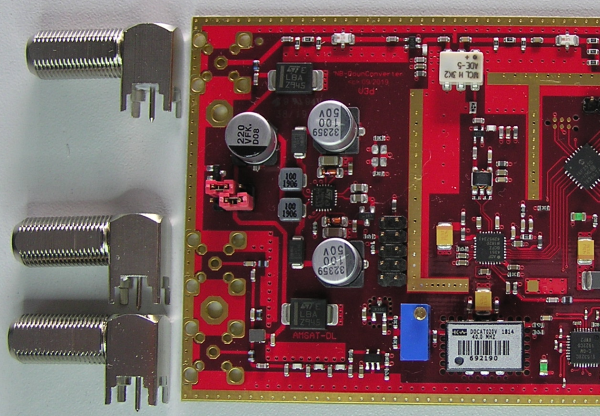User Tools
Sidebar
Table of Contents
AMSAT-DL QO-100 DownConverter V3d
Overview
In early 2019, the first version of the AMSAT-DL downconverter was built and many stations became active with it for the first time on QO-100. Since then, lots of operational experience and new knowledge has been gained, which has been incorporated into the new V3d board.
The AMSAT-DL DownConverter V3d is a completely new development. It offers important functions for all QO-100 stations, no matter if you work with VHF/UHF, KW transceivers or SDR. This new board can be used as a central board. It provides stable clocks for all components, additional external GPS modules are not required.
The following functions are available in AMSAT-DL DownConverter V3d:
- central clock generation with GPS or OCXO
- reference clock for the PLL in the LNB
- reference clock for a transmit mixer
- reference clock for a SDR
- short-circuit proof LNB phantom power supply
- Connection for a dual LNB (for simultaneous NB and WB reception)
- Downmixing of the NB transponder to an Afu band (UHF/VHF or KW)
- OLED display to show operating status and station coordinates
Central clock generation
The AMSAT-DL DownConverter V3d has a TCXO with stabilization by the GPS V2 module or another 10 MHz reference.
In 2019/2020 boards with OCXO were also built, which were replaced by the TCXO/GPS version from 2021.
For the reception of QO-100 a commercial LNB is used. This uses as reference frequency a quartz (usually 25 MHz). This frequency is multiplied by 390 in the LNB and fed to the LNB-internal mixer. Shortly after QO-100 started operation, most stations noticed a considerable drift of the received signal. By multiplying the reference frequency by 390, even the smallest error is also multiplied by this factor. For this reason it is inevitable to replace the frequency generation of the LNB with a very stable clock.
The AMSAT-DL DownConverter V3d therefore has a GPS module built in as standard. From this reference all required further clocks are derived by PLLs and made available at corresponding connectors or sockets:
- Reference frequency for the LNB of 24, 25 or 26 MHz (adjustable).
- 10 MHz for a transmit mixer or e.g. for the IC9700
- 40 MHz for the AMSAT-DL upconverter or an SDR (e.g. Adalm Pluto)
Requirements for SSB reception of the NB transponder:
In SSB operation you need a frequency constancy of at least 10 Hz for a clean voice signal. Because of the LNB internal multiplication around 390, the reference frequency must have an extremely low jitter and be very stable which can only be achieved with GPS.
The AMSAT-DL DownConverter V3d contains a GPS receiver and the necessary PLLs to process its reference clock. The supplied GPS antenna is connected. As soon as at least 4 GPS satellites are received, the clock generation synchronizes to the clock output of the GPS module and provides all clocks listed above.
Requirements for the reception of the WB transponder:
A DVB-S2 signal has completely different requirements to the signal quality than a SSB signal. Here the frequency stability is not important. A drift of a few kHz is no problem. However, the quadrature modulation used in DVB-S2 requires a minimum of phase noise. The reference signal must be as clean as possible.
Until the end of 2020, an OCXO version was offered for this purpose. In the meantime, an improved GPS solution with regard to phase noise is available with the GPS Module V2, which replaces the OCXO version.
For SDR users:
If you use a SDR (e.g. Adalm Pluto, Lime SDR etc.) you also need a precise clock. Therefore the AMSAT-DL DownConverter V3d has been equipped with a 40 MHz reference output. This can usually be connected directly to a corresponding input of the SDR. Please check the specified input level of the SDR and adjust the level by means of an attenuator if necessary. Furthermore, this 40 MHz clock is provided for the synchronization of the Amsat-DL upconverter.


